At noon on the 4th, China's Everest expedition team successfully reached the summit and used high-precision radar to measure the thickness of snow and ice on the summit for the first time
At about 12:46 on the 4th, Chinese scientific research team successfully set up the world's highest automatic weather station on Everest.

On May 4, the scientific research team climbed to the top of Mount Everest. Photo by special correspondent of Xinhua News Agency sorandoji
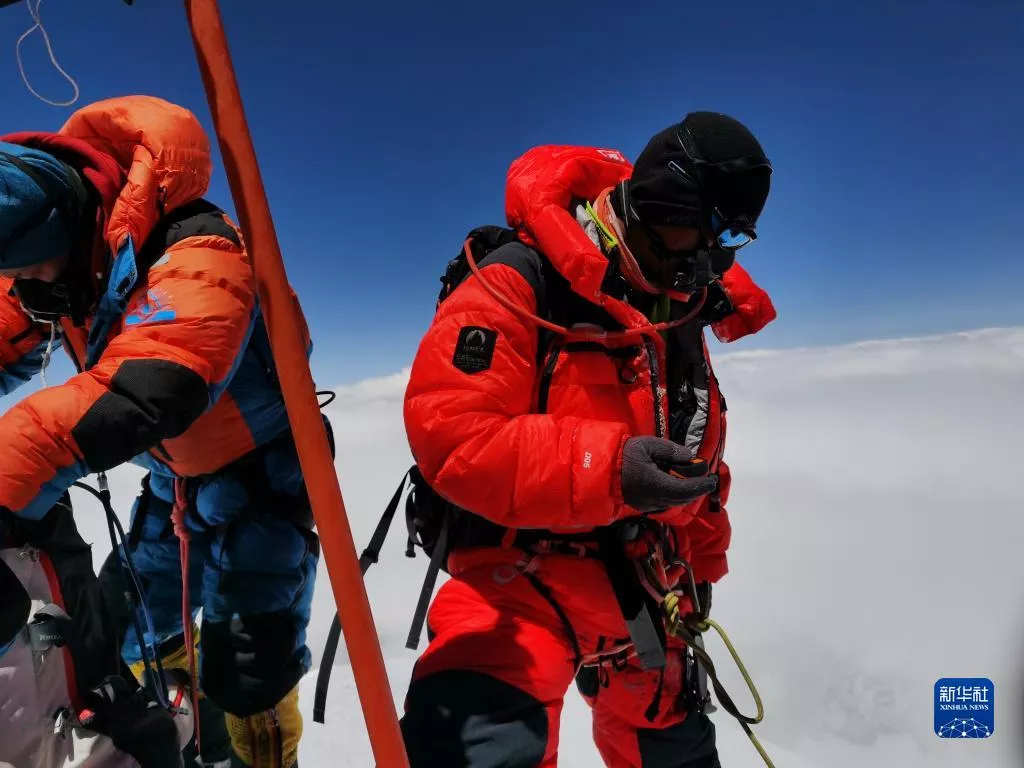
Climbing process:
Let's go! The "rush hour" was opened at 3 a.m. this morning by 13 members of the Everest scientific expedition
The reporter learned from the "peak mission" Everest scientific research front headquarters that at 3 a.m. on May 4, 13 scientific research team members carried scientific research equipment and set out from the assault camp at an altitude of 8300 meters to open the "rush moment" of scientific research. It is expected that at 7:00 a.m. on the 4th, they will arrive at an altitude of 8800 meters. First, they will build an automatic weather observation station with the highest altitude in the world. At present, the team members are in good health. They will also carry out comprehensive scientific research tasks such as radar measurement of ice thickness and collection of ice and snow samples at the summit.
In addition, according to the latest meteorological service information provided by the Meteorological Bureau of the Tibet Autonomous Region, it was cloudy and overcast on May 4. The height of Everest ranged from 7000 meters to 9000 meters. The wind direction was mainly West or northwest, with a wind speed of 6 ~ 14 meters / s. The weather condition was good.
One team member who reached the top of the scientific examination suffered frostbite on his hand, and the other 12 team members continued to rush to the top of Mount Everest
Today (May 4), "peak mission" Everest scientific research will start the "peak rush moment". The 12 members of the scientific research team will work together with the front headquarters of the Everest base camp at the summit to jointly complete the most critical and challenging comprehensive task of scientific research at the summit.
Including the erection of the world's highest automatic weather station at an altitude of 8800 meters; It is the first time to use high-precision radar to measure the thickness of ice and snow, collect ice and snow samples, and experiment on the adaptation mechanism of human body to high altitude.
The Qinghai Tibet Plateau is the roof of the world, the water tower of Asia and the third pole of the earth. China has carried out more than six scientific research activities on Everest since the 1950s, including the first large-scale comprehensive scientific investigation and Research on the Qinghai Tibet Plateau in the 1970s. The "peak mission" Everest scientific research was fully launched on April 28 this year, with a total of 5 scientific research teams, 16 scientific research teams and more than 270 scientific research team members participating. This is a comprehensive scientific research with the widest coverage of disciplines, the largest number of scientific research team members and the most advanced instruments and equipment since the second Qinghai Tibet scientific research in 2017. It is a feat of human beings to carry out high-altitude comprehensive scientific investigation and research in the Everest region.
At 3 a.m. this morning, due to frostbite on the hands of one scientific expedition climber, he remained at an altitude of 8300 meters. The other 12 scientific expedition climbers have set out from the assault camp at an altitude of 8300 meters. They are expected to arrive at 8800 meters around 9 o'clock, set up a meteorological station and carry out a series of scientific expedition tasks. The multi-channel reporter from the head office will also take you live to witness how the "peak mission" is realized and the birth of the world record for scientific research on the top of the world!
China's Everest scientific research team successfully reached the top
At noon on the 4th, China's Everest expedition team successfully reached the summit and used high-precision radar to measure the thickness of snow and ice on the summit for the first time.
China's Everest expedition team has successfully set up the world's highest automatic weather station
At about 12:46 on the 4th, Chinese scientific research team successfully set up the world's highest automatic weather station on Everest.
The members of the scientific research summit displayed the five-star red flag at the summit

"Peak mission 2022" Everest scientific research team members display the five-star red flag at the top of Everest.
Related reading:
The first automatic weather station with an altitude of 8830 meters has been set up successfully! What does the success of the Everest scientific research team mean (upstream News)
At 3 a.m. on May 4, 13 scientific research team members who took part in the "peak mission" scientific research of Everest began to rush to the top from the assault camp 8300 meters above sea level in the dark. At 12:22, the scientific research team members of the first echelon successfully reached the top.
On April 28, 2022, the "peak mission" Everest scientific research was fully launched, with a total of 16 scientific research teams and more than 270 scientific research team members participating. This is a comprehensive scientific examination with the widest coverage of disciplines, the largest number of participants and the most advanced instruments and equipment since the second Qinghai Tibet scientific examination. It is a feat for human beings to carry out high-altitude comprehensive scientific investigation and research in the Everest region.
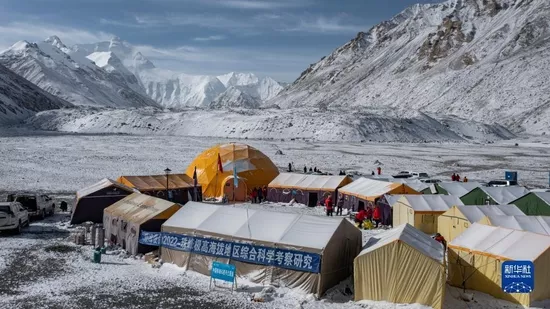
"Peak mission" Everest scientific research base map: Xinhua News Agency
It is understood that the "peak mission" scientific investigation of Everest will break through the altitude of more than 8000 meters for the first time, complete the comprehensive scientific investigation task of Everest peak, and plan to create a number of world records for scientific investigation and research.
After reaching the top of the scientific examination, 13 team members will be divided into three groups to complete three tasks at the same time. It includes setting up the world's highest meteorological station at 8800 meters, measuring the thickness of ice and snow with high-precision radar, and carrying out experiments on the adaptation mechanism of human body to high altitude.
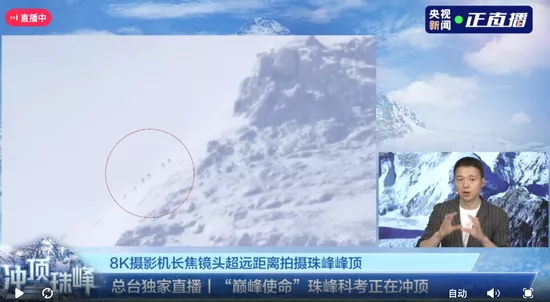
CCTV live screen
Achievement 1: set up automatic weather station with the highest altitude in the world
An important task of the scientific research of Everest this time is to build eight weather stations from 5200 meters to 8800 meters above sea level, of which four are above 7000 meters above sea level. In particular, an automatic weather station weighing up to 50kg will be erected at 8800m above sea level of Everest, which will become the highest automatic weather station in the world, realize automatic observation and data transmission of meteorological gradient in the extremely high altitude area of Everest, and the measured data obtained will fill the gap of meteorological records at extremely high altitude of Everest.
It is reported that the automatic weather station is powered by solar panels and can be used for 2 years under normal circumstances. It can transmit meteorological information such as temperature, humidity, wind direction, wind speed and solar radiation through satellite communication. After the automatic weather station is set up successfully, the returned meteorological information can be received within 12 minutes.
At 12:46, the weather station was successfully erected. After measurement, the final installation position of the automatic weather station is 8830 meters above sea level. Experts at the "peak mission" Everest scientific research base suggest that the automatic weather station be named "peak weather station".
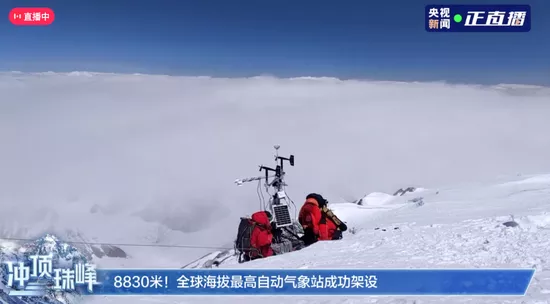
CCTV live screen
Achievement 2: measure the thickness of ice and snow on the top of the earth
Detecting the thickness of ice and snow on the peak is also the focus and difficulty of this scientific research. The expedition will use high-precision radar to measure the thickness of ice and snow on the top of the earth for the first time. The high-precision ground penetrating radar carried by the climbers will not only measure the peak, but also measure the whole Rongbu glacier on Everest. It is also planned to complete the collection of 5800-8300 meters of snow, ice and rock samples and drill the ice core. Wu Guangjian, a researcher at the Qinghai Tibet Plateau Research Institute of the Chinese Academy of Sciences, said: in addition to measuring the thickness of snow and ice on the top of Mount Everest, we want to know what components are in the surface snow at the highest altitude.
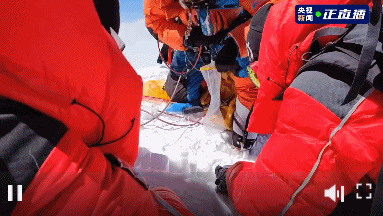 The scientific research team collected ice and snow samples at the top of Everest. Picture: CCTV live broadcast
The scientific research team collected ice and snow samples at the top of Everest. Picture: CCTV live broadcast
In this scientific research, China's self-developed "jimu-1" type III floating boat will debut for the first time, trying to break the world record of atmospheric observation altitude of floating boat. The launch target is expected to exceed the altitude of Mount Everest to 9000 meters.

Schematic diagram of "peak mission" Everest scientific research task: CCTV news
Achievement 3: experiment on adaptation mechanism of human body to high altitude
This scientific research will also track the transportation of air pollution at very high altitude and the adaptability of scientific researchers at high altitude.
Zhu Tong, academician of the Chinese Academy of Sciences and Dean of the school of environmental science and engineering of Peking University, is a researcher who participated in the "peak mission - comprehensive scientific investigation and Research on the extremely high altitude area of Mount Everest". They took their own body as the experimental object to explore the impact of altitude reaction on the human body.
For research needs, some scientific research members will wear blood oxygen and heart rate patches and climb to an altitude of 6350 meters or even higher. "Many members of the team have arrived at the area with an altitude of 6350 meters. I am actively training these days and look forward to meeting them there. Along the way, my body will change accordingly with the increase of altitude. This intuitive data is more enlightening to me." Zhu Tong said.
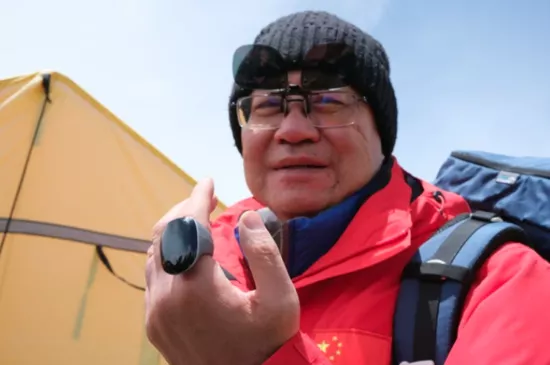
Academician Zhu Tong is displaying a wearable ambulatory ECG recorder for scientific research, photographed by Xinhua News Agency reporter Sun Fei
In order to obtain more data, the scientific research team will track the people who are active at the altitude of 5200 meters, 5800 meters, 6350 meters and 8848 meters, and carry out scientific research on the human health effects of hypoxia at high altitude.
"What's different from the past is that this time we emphasize what drastic changes will happen to the human body in high altitude areas. If the human body is exposed to some pollutants in the drastic changes, such as air pollution, then the high cold, hypoxia and environmental pollution at high altitude will have a superposition effect on the human body." Zhu Tong said.
